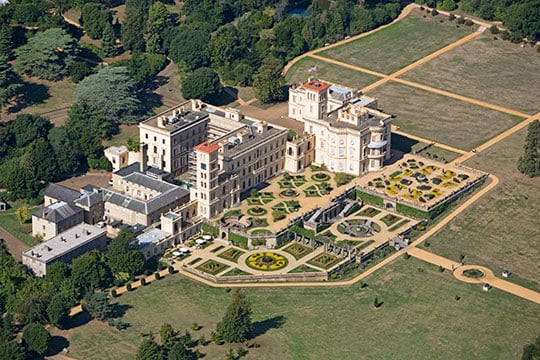Significance of Osborne
Osborne is of outstanding significance for its close association with Queen Victoria and Prince Albert, and for the survival of the house and its original contents largely intact. Both the house and landscape provide an exceptional insight into the private life, tastes and interests of the royal couple.

Survival
The survival of Osborne with interiors and grounds in something very close to their designed state provides important evidence for the appearance and working of a 19th-century royal residence. The house is of particular value for its overall state of preservation, evidence of historic decorative schemes and construction techniques, and features associated with its service infrastructure.
The formal gardens are the best surviving example of Prince Albert’s taste as a garden designer and his adoption of the Italian style of the Renaissance.
Design of the House
Osborne is unusual among 19th-century country houses in being a new building on an existing site rather than an extension of an existing house.
The plan of Osborne was not a typical one for a royal household, but was developed for a specific family use. It is of great historical value in reflecting both the personal tastes and requirements of the royal family, and the complex hierarchical organisation of the royal household.
The Role of Queen Victoria
The close association of Osborne with Queen Victoria, over most of her long reign, gives it considerable value. It reflects with great clarity her personal attachments and enthusiasms, the extent of her affection for Prince Albert and their children, and the range of her interests and activities.
Osborne is valuable too for its ability to communicate the queen’s symbolic role as monarch and head of empire, through the arrangements for the royal household and the functions of government seen in the Audience and Council Rooms.
Technological Innovation
The range of technological innovations introduced at Osborne is extensive and substantially intact. Most of the regular technical advances of the 19th century are represented at Osborne, and in some areas it was ahead of its time, thanks in great measure to Prince Albert’s scientific and technological interests and enthusiasms.
Radical and progressive features in the initial building of Osborne were the use of fireproof construction throughout, the partial heating and ventilation systems, and the hot water bath and shower arrangements. Later advances – the lift, telephone and electric lighting – show the queen’s ready adoption of further innovations.
Decoration and Contents
The collections at Osborne remain the single most important example of the shared tastes of Queen Victoria and Prince Albert. They are intensely personal, with many items being commissioned by the royal couple and given to each other as birthday and Christmas presents. Their shared interest in acquiring art, and discussing and planning the development and arrangement of their collection at Osborne, is unique in the artistic history of the British monarchy.
Through their enthusiastic patronage of a wide range of contemporary artists in both Britain and Europe, the collection represents a wide spectrum of creativity, and is outstanding as an assembly of mid-19th-century works of art. The sculpture collection had few rivals at the time as a reflection of contemporary taste and is now the most important to survive from the period.
The Indian collections, largely gifts and acquisitions to celebrate Queen Victoria’s role as Empress of India, are of considerable ethnographic interest. The collections in the Swiss Cottage and Museum, an exercise in education for the royal children, reflect a contemporary interest in exploring and recording the human and natural worlds, and are an important example of 19th-century collection and display.
After Victoria and Albert
The Royal Naval College Osborne made an important contribution to the training of naval cadets both before and during the First World War.
The opening of the ground floor of the pavilion and Swiss Cottage gardens in 1904 was a significant step in that it allowed public access to a royal residence, and helped to perpetuate the image and celebrity of Queen Victoria.
The surviving evidence for the convalescent home (1904–2000) in the changes of room use and conversions demonstrates how extensive this occupation was. Much survives to demonstrate the character and development of the house as a place of medical and social care for a long succession of patients.
READ MORE ABOUT OSBORNE
